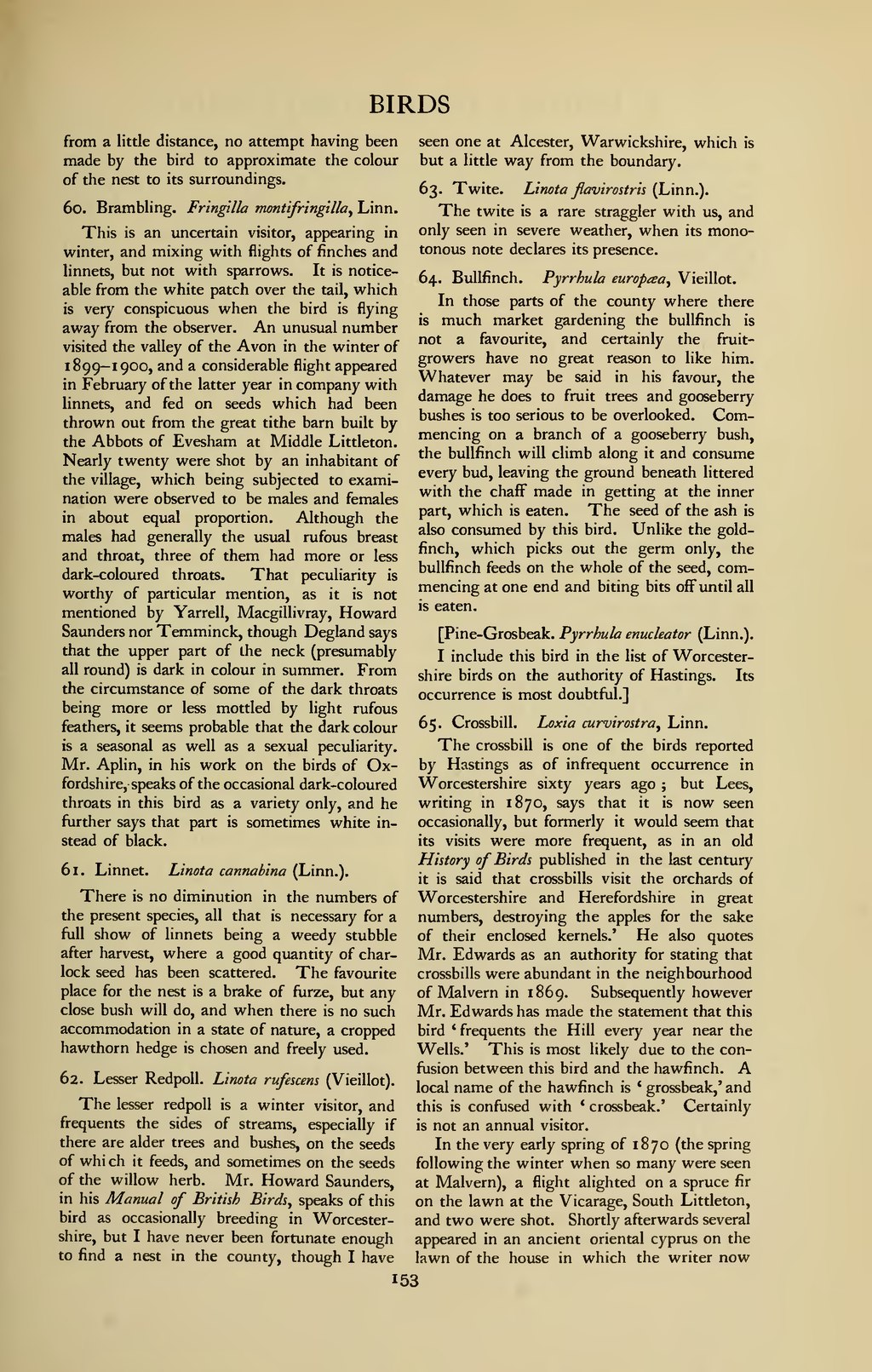BIRDS from a little distance, no attempt having been made by the bird to approximate the colour of the nest to its surroundings. 60. Brambling. Fringilla montifringilla, Linn. This is an uncertain visitor, appearing in winter, and mixing with flights of finches and linnets, but not with sparrows. It is notice- able from the white patch over the tail, which is very conspicuous when the bird is flying away from the observer. An unusual number visited the valley of the Avon in the winter of 1 899-1 900, and a considerable flight appeared in February of the latter year in company with linnets, and fed on seeds which had been thrown out from the great tithe barn built by the Abbots of Evesham at Middle Littleton. Nearly twenty were shot by an inhabitant of the village, which being subjected to exami- nation were observed to be males and females in about equal proportion. Although the males had generally the usual rufous breast and throat, three of them had more or less dark-coloured throats. That peculiarity is worthy of particular mention, as it is not mentioned by Yarrell, Macgillivray, Howard Saunders nor Temminck, though Degland says that the upper part of the neck (presumably all round) is dark in colour in summer. From the circumstance of some of the dark throats being more or less mottled by light rufous feathers, it seems probable that the dark colour is a seasonal as well as a sexual peculiarity. Mr. Aplin, in his work on the birds of Ox- fordshire, speaks of the occasional dark-coloured throats in this bird as a variety only, and he further says that part is sometimes white in- stead of black. 61. Linnet. Linota cannabina (Linn.). There is no diminution in the numbers of the present species, all that is necessary for a full show of linnets being a weedy stubble after harvest, where a good quantity of char- lock seed has been scattered. The favourite place for the nest is a brake of furze, but any close bush will do, and when there is no such accommodation in a state of nature, a cropped hawthorn hedge is chosen and freely used. 62. Lesser Redpoll. Linota rufescens (Vieillot). The lesser redpoll is a winter visitor, and frequents the sides of streams, especially if there are alder trees and bushes, on the seeds of which it feeds, and sometimes on the seeds of the willow herb. Mr. Howard Saunders, in his Manual of British Birds, speaks of this bird as occasionally breeding in Worcester- shire, but I have never been fortunate enough to find a nest in the county, though I have seen one at Alcester, Warwickshire, which is but a little way from the boundary. 63. Twite. Linota flavirostris (Linn.). The twite is a rare straggler with us, and only seen in severe weather, when its mono- tonous note declares its presence. 64. Bullfinch. Pyrrhula europaa, Vieillot. In those parts of the county where there is much market gardening the bullfinch is not a favourite, and certainly the fruit- growers have no great reason to like him. Whatever may be said in his favour, the damage he does to fruit trees and gooseberry bushes is too serious to be overlooked. Com- mencing on a branch of a gooseberry bush, the bullfinch will climb along it and consume every bud, leaving the ground beneath littered with the chaff made in getting at the inner part, which is eaten. The seed of the ash is also consumed by this bird. Unlike the gold- finch, which picks out the germ only, the bullfinch feeds on the whole of the seed, com- mencing at one end and biting bits off until all is eaten. [Pine-Grosbeak. Pyrrhula enucleator (Linn.). I include this bird in the list of Worcester- shire birds on the authority of Hastings. Its occurrence is most doubtful.] 65. Crossbill. Loxia curvirostra, Linn. The crossbill is one of the birds reported by Hastings as of infrequent occurrence in Worcestershire sixty years ago ; but Lees, writing in 1870, says that it is now seen occasionally, but formerly it would seem that its visits were more frequent, as in an old History of Birds published in the last century it is said that crossbills visit the orchards of Worcestershire and Herefordshire in great numbers, destroying the apples for the sake of their enclosed kernels.' He also quotes Mr. Edwards as an authority for stating that crossbills were abundant in the neighbourhood of Malvern in 1869. Subsequently however Mr. Edwards has made the statement that this bird ' frequents the Hill every year near the Wells.' This is most likely due to the con- fusion between this bird and the hawfinch. A local name of the hawfinch is ' grossbeak,' and this is confused with ' crossbeak.' Certainly is not an annual visitor. In the very early spring of 1870 (the spring following the winter when so many were seen at Malvern), a flight alighted on a spruce fir on the lawn at the Vicarage, South Littleton, and two were shot. Shortly afterwards several appeared in an ancient oriental Cyprus on the lawn of the house in which the writer now t53
